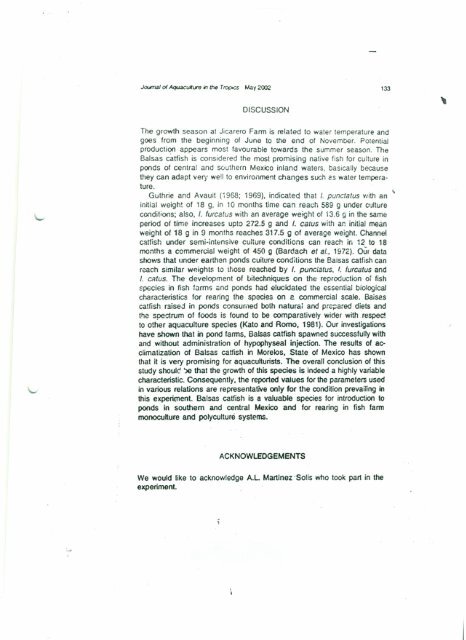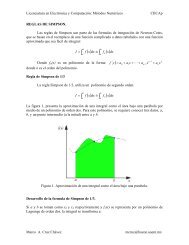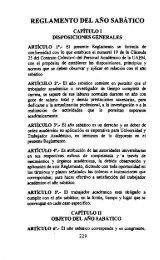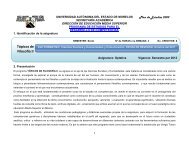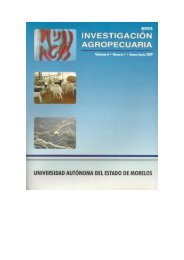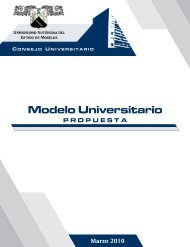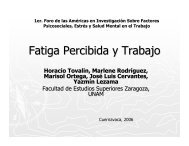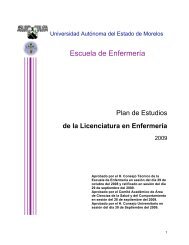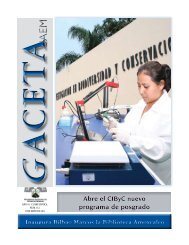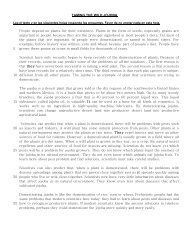Growth and Production of the Balsas Catfish, Ictalurus ... - UAEM
Growth and Production of the Balsas Catfish, Ictalurus ... - UAEM
Growth and Production of the Balsas Catfish, Ictalurus ... - UAEM
You also want an ePaper? Increase the reach of your titles
YUMPU automatically turns print PDFs into web optimized ePapers that Google loves.
Jouma1 o( Aqucicuture ., th6 TfOP'CS Ma Y 2002 133<br />
DISCUSSION<br />
The growth season at Jicarero Farm is related to water temperature <strong>and</strong><br />
goes from <strong>the</strong> beginning 01 June lo <strong>the</strong> end 01 November. PotentiaJ<br />
productioo appears most lavourable towards <strong>the</strong> summer season. The<br />
<strong>Balsas</strong> catfish is considered <strong>the</strong> mosl promising native lish tor culture in<br />
ponds <strong>of</strong> central <strong>and</strong> sou<strong>the</strong>rn Mexico inl<strong>and</strong> waters, basically because<br />
<strong>the</strong>y can adapt ver)' well to environment changes such as water temperature.<br />
Guthrie <strong>and</strong> Avauit (~968; 1969), indicated that l. punctatus with an \¡<br />
inñial weigh! <strong>of</strong> 18 g, in 10 months time can reach 589 g under cultura<br />
conditioos: also, l. furcatus with an average weighl <strong>of</strong> 13.6 9 in <strong>the</strong> same<br />
period <strong>of</strong> time in creases upto 272.5 9 <strong>and</strong> l. eatus wilh aro initia! mean<br />
weighl <strong>of</strong> 18 9 in 9 months reaches 317.5 9 <strong>of</strong> average weight. Channel<br />
catfish under semi-intensive culture cooditions can reach ir. 12 lo 18<br />
monlhs a commercial weight <strong>of</strong> 450 9 (Bardach et al., 1972). Our data<br />
shows that unoer ear<strong>the</strong>n poods cuíture conditions <strong>the</strong> Baisas catfish can<br />
reacn similar wp.ights to those reached by l. punctatus, 1. furcatus aliá<br />
l. estos. The development <strong>of</strong> bitechniques on <strong>the</strong> reproduction oí fish<br />
species in fish farms <strong>and</strong> ponds had elucidated <strong>the</strong> essential biological<br />
characteristics for rearing Ihe specles on 2. commercial scale. <strong>Balsas</strong><br />
catfish raised in ponds consumed both natural <strong>and</strong> precared diets <strong>and</strong><br />
<strong>the</strong> spectrum <strong>of</strong> foods is found to be comparatively wider with. respect<br />
to o<strong>the</strong>r aquaculture species (Kato <strong>and</strong> Romo, 1981). Our investigations<br />
have shown that in pond farms, <strong>Balsas</strong> catñsh spawned successfully with<br />
<strong>and</strong> without administration ot hypophyseal injection. The results ot acclimatization<br />
ot <strong>Balsas</strong> catfish in Morelos, State. <strong>of</strong> Mexico has shown<br />
that it is very promising for aquaculturists. The overall conclusion <strong>of</strong> this<br />
study shoulé ')e that <strong>the</strong> growth <strong>of</strong> this species is indeed a highly variable<br />
characteristic. ConsequenUy, <strong>the</strong> reported values for <strong>the</strong> parameters used<br />
in various relations are representativa ooly for <strong>the</strong> condition prevailing in<br />
this experíment. <strong>Balsas</strong> catfish is a valuable species tor introduction to<br />
ponds in sou<strong>the</strong>m <strong>and</strong> central Mexico <strong>and</strong> tor rearing in fish farrn<br />
monoculture <strong>and</strong> polyculturé systems.<br />
ACKNOWLEDGEMENTS<br />
We would like to acknowledge A.L Martinez ·Solís who took part in <strong>the</strong><br />
experiment.<br />
\


